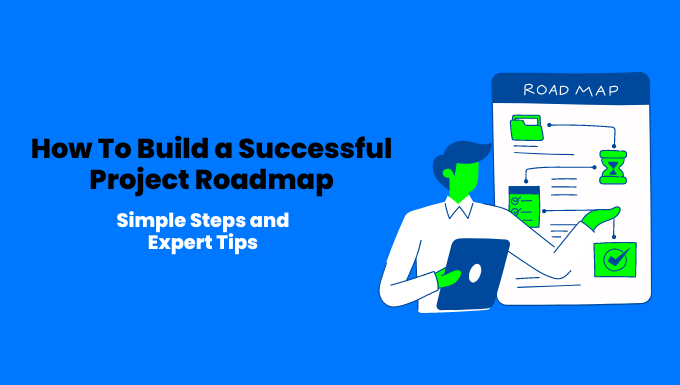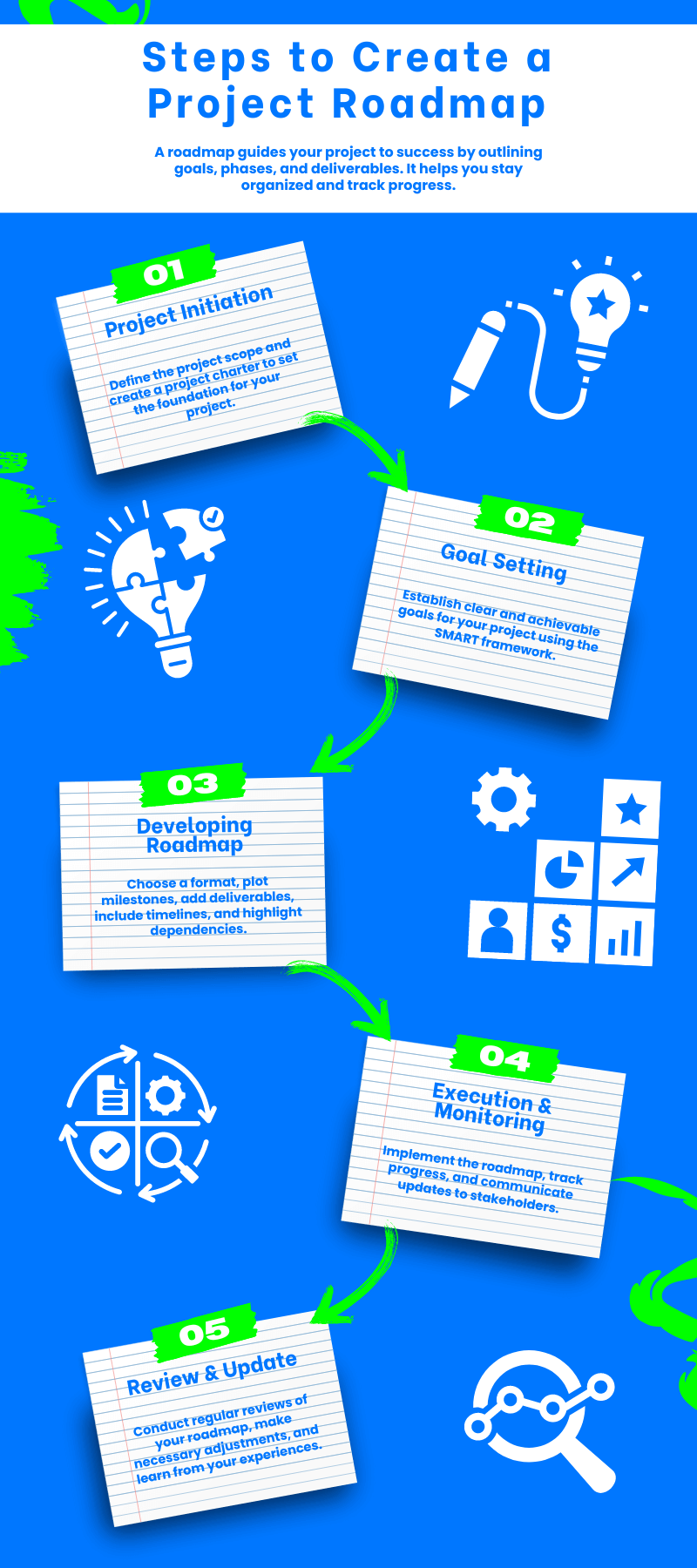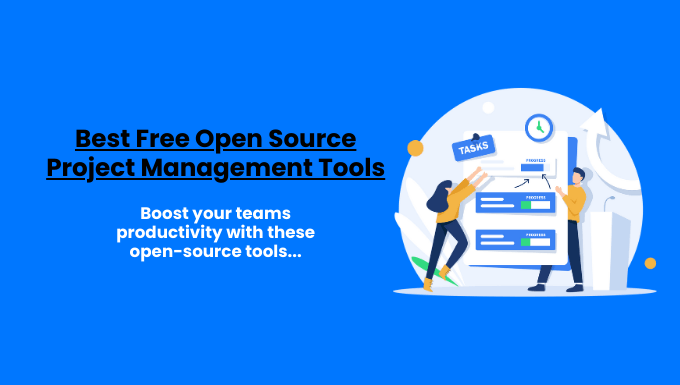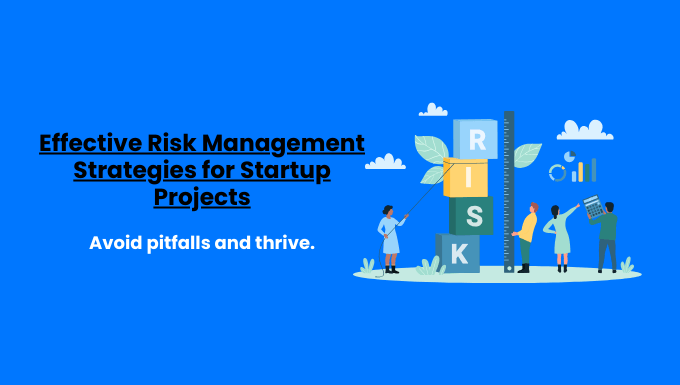Ever felt lost while steering your business venture? A project roadmap is your entrepreneurial GPS.
This strategic tool transforms your big idea into a clear, actionable plan.
It guides you from concept to successful execution, keeping everyone aligned.
Imagine having a bird’s-eye view of your project, spotting potential roadblocks before they become issues, and communicating your vision effectively to stakeholders.
Learn how to craft a winning project roadmap and set your venture on the path to success.
Key Takeaways:
- A project roadmap outlines major phases, key deliverables, and critical milestones.
- Well-crafted roadmaps improve resource management and stakeholder communication.
- Include clear goals, timelines, and risk management strategies in your roadmap.
- Use digital tools like Trello or Asana to create and manage your project roadmap.
- Regularly review and update your roadmap to ensure it stays relevant and useful.
According to a study by the Project Management Institute, organizations that use project management practices waste 28 times less money than those that don’t.
That’s a compelling reason for any entrepreneur to master the art of project road mapping.

Contents
ToggleUnderstanding the Project Roadmap
What is a Project Roadmap?
Imagine you’re planning a cross-country road trip. You wouldn’t just hop in the car and start driving, would you?
You’d want a map showing the major cities you’ll pass through, key attractions, and an estimated timeline. That’s essentially what a project roadmap does for your business venture.
A project roadmap is a strategic overview that visualizes the key elements of your project. It’s not about the nitty-gritty details, that’s what your project plan is for. Instead, the roadmap focuses on the big picture, outlining:
- Major goals and objectives
- Key deliverables and milestones
- High-level timelines
- Dependencies between different project phases
Think of it as the 30,000-foot view of your project. It’s the document you’d show to executives or stakeholders to give them a quick understanding of where the project is headed and how it aligns with overall business goals.
Why You Need a Project Roadmap
You might be thinking, “I’ve got a project plan. Isn’t that enough?” Not quite. Here’s why a roadmap is crucial:
- Clarity and Focus: It keeps everyone’s eyes on the prize. In the day-to-day grind, it’s easy to lose sight of the bigger picture. A roadmap reminds everyone of the ultimate goals.
- Stakeholder Communication: It’s an excellent tool for managing expectations and keeping stakeholders informed without overwhelming them with details.
- Resource Planning: By seeing the project laid out visually, you can better anticipate resource needs and allocate them effectively.
- Risk Management: A bird’s-eye view makes it easier to spot potential conflicts or bottlenecks before they become problems.
- Flexibility: Unlike a detailed project plan, a roadmap is easier to adjust when circumstances change, and in the entrepreneurial world, change is the only constant.
According to a survey by Wellingtone, 50% of project managers say that incomplete requirements are the primary reason for project failure.
A well-crafted roadmap helps ensure that key requirements are captured and communicated from the start.
| Benefits of Project Roadmaps | Percentage of Project Managers Who Agree |
|---|---|
| Improved Stakeholder Communication | 78% |
| Better Resource Management | 65% |
| Enhanced Risk Mitigation | 59% |
| Increased Project Success Rate | 72% |
Remember, a project roadmap isn’t just a pretty document to impress stakeholders. It’s a dynamic tool that, when used effectively, can be the difference between a project that meanders aimlessly and one that drives purposefully toward success.
Key Components of a Project Roadmap
Creating a project roadmap isn’t about throwing together a fancy timeline and calling it a day. It’s about crafting a strategic document that guides your project from conception to completion.
Let’s break down the key ingredients that make up a robust project roadmap.
1. Project Goals and Objectives
At the heart of every successful project are clear, well-defined goals and objectives. These are the North Star that guides every decision and action throughout the project lifecycle.
- Goals: These are the big-picture outcomes you’re aiming for. They answer the question, “What are we trying to achieve?”
- Objectives: These are the specific, measurable steps that will help you reach your goals. They should be SMART: Specific, Measurable, Achievable, Relevant, and Time-bound.
For example, if you’re launching a new app, your goal might be “To become the leading productivity app in the market,” while an objective could be “To acquire 100,000 active users within the first six months of launch.“
2. Milestones and Deliverables
Milestones are the significant checkpoints in your project journey. They mark important achievements or phases and help you measure progress. Deliverables, on the other hand, are the tangible or intangible outputs you produce along the way.
- Milestones: Examples include “Product Design Finalized,” “Beta Testing Completed,” or “Marketing Campaign Launched.”
- Deliverables: These could be things like “Wireframes,” “Beta Version of the App,” or “Marketing Materials.”
A study by PMI found that projects with clearly defined milestones are 50% more likely to be completed on time and within budget.
3. Timelines and Schedules
While a roadmap isn’t a detailed project schedule, it should provide a high-level timeline that outlines when major phases and milestones are expected to occur.
- Use date ranges rather than specific dates to allow for flexibility.
- Highlight dependencies between different phases or deliverables.
- Consider using a Gantt chart for a visual representation of your timeline.
4. Resource Allocation
Your roadmap should give a broad overview of the resources required at different stages of the project. This includes:
- Team members and their roles
- Budget allocation
- Equipment or technology needs
According to a Gartner study, poor resource management is responsible for 25% of project failures. Your roadmap can help prevent this by providing a clear picture of resource needs throughout the project lifecycle.
5. Risk Management
No project is without risks. Your roadmap should identify potential obstacles and outline strategies for managing them.
- List major risks that could impact the project.
- Provide high-level mitigation strategies for each risk.
- Assign risk owners responsible for monitoring and addressing each risk.
A survey by KPMG revealed that organizations with mature risk management practices have a project success rate of 86%, compared to just 47% for those with minimal risk management.
| Component | Purpose | Example |
| Goals & Objectives | Set direction | Become market leader; Acquire 100,000 users |
| Milestones & Deliverables | Mark progress | Beta launch; Marketing materials |
| Timelines | Provide schedule | Q3 2024: Public launch |
| Resource Allocation | Plan resources | 3 developers in Q2; $50k marketing budget |
| Risk Management | Identify obstacles | Data security breach; Mitigation: Implement robust encryption |
Remember, a great project roadmap is like a well-crafted story. It should clearly communicate your project’s journey, from the exciting beginning to the triumphant end, with all the important plot points in between.
Steps to Create a Project Roadmap
Now that we’ve covered the key components, let’s roll up our sleeves and dive into the process of creating a project roadmap.

Follow these steps to craft a roadmap that will guide your project to success.
Step 1: Project Initiation
Before you start mapping out your journey, you need to know where you’re going and why.
- Define the project scope: Clearly outline what is and isn’t included in your project. This helps prevent scope creep, which, according to PMI, affects 52% of projects.
- Create a project charter: This document formally authorizes the project and outlines its purpose, objectives, and high-level requirements. Example Project Charter Elements:
- Project Purpose
- Objectives
- High-level Requirements
- Stakeholders
- Budget Overview
- Project Manager Authority
Step 2: Goal Setting and Planning
With your project initiated, it’s time to set your destination and plan your route.
- Establish project goals: Use the SMART framework to set clear, achievable goals.
- Plan project phases and tasks: Break your project into manageable phases and identify key tasks within each phase. Example Project Phases for a Software Launch:
- Conceptualization and Planning
- Design and Development
- Testing and Quality Assurance
- Marketing and Pre-launch
- Launch and Post-launch Support
Step 3: Developing the Roadmap
Now comes the exciting part – creating your actual roadmap!
- Choose a format: Decide whether you’ll use a timeline, Gantt chart, or another visual format that best suits your project and stakeholders.
- Plot major milestones: Add your key milestones to the roadmap, ensuring they align with your project goals.
- Include deliverables: Associate deliverables with each milestone to provide clarity on what will be produced.
- Add timelines: Include rough timeframes for each phase and milestone. Remember, a roadmap is high-level, so use date ranges rather than specific dates.
- Highlight dependencies: Show how different phases or deliverables relate to each other.
Step 4: Execution and Monitoring
Your roadmap isn’t a “set it and forget it” document. It should evolve with your project.
- Implement the roadmap: Use it as a guide for your day-to-day project management.
- Track progress: Regularly update the roadmap to reflect completed milestones and any changes in timelines or deliverables.
- Communicate updates: Keep stakeholders informed of progress and any significant changes to the roadmap.
Step 5: Review and Update
As your project progresses, your roadmap should adapt.
- Conduct regular reviews: Schedule periodic reviews of your roadmap to ensure it still aligns with project goals and realities.
- Make necessary adjustments: Don’t be afraid to update your roadmap if circumstances change. A flexible roadmap is a useful roadmap.
- Learn and improve: After project completion, review your roadmap’s effectiveness and note lessons learned for future projects.
Remember, creating a project roadmap is both an art and a science. It requires a balance of strategic thinking, practical planning, and clear communication.
By following these steps and continually refining your approach, you’ll be well on your way to mastering the art of project road mapping.
| Step | Key Activities | Tools/Techniques |
|---|---|---|
| Project Initiation | Define scope, Create charter | Scope statement, Project charter template |
| Goal Setting and Planning | Establish SMART goals, Plan phases | SMART goal framework, Work Breakdown Structure (WBS) |
| Developing the Roadmap | Choose format, Plot milestones, Add timelines | Gantt charts, Timeline software |
| Execution and Monitoring | Implement roadmap, Track progress | Project management software, Status reports |
| Review and Update | Conduct reviews, Make adjustments | Review meetings, Lessons learned log |
Tools and Software for Roadmap Creation
In today’s digital age, entrepreneurs have a wealth of tools at their fingertips to create stunning and functional project roadmaps.
Let’s explore some popular options that can take your road mapping game to the next level.
Popular Project Management Tools
- Trello
- Best for: Visual thinkers and teams who prefer a card-based interface
- Key features: Kanban boards, checklists, due dates, file attachments
- Pricing: Free basic version, paid plans start at $10/user/month
- Pro tip: Use Trello’s “Timeline” view for a visual roadmap representation
- Asana
- Best for Teams looking for a versatile, feature-rich tool
- Key features: Timeline view, dependencies, milestones, custom fields
- Pricing: Free basic version, premium plans start at $10.99/user/month
- Pro tip: Utilize Asana’s “Timeline” feature for a Gantt-chart style roadmap
- Jira
- Best for: Software development teams and complex projects
- Key features: Scrum and Kanban boards, roadmaps, issue tracking
- Pricing: Free for up to 10 users, paid plans start at $7/user/month
- Pro tip: Use Jira’s “Advanced Roadmaps” for portfolio-level planning
- Microsoft Project
- Best for: Large enterprises and complex project management
- Key features: Gantt charts, resource management, portfolio management
- Pricing: Starts at $10/user/month
- Pro tip: Leverage its powerful reporting features for stakeholder communications
- Airtable
- Best for Teams that need a customizable, spreadsheet-like interface
- Key features: Multiple views (Grid, Calendar, Gantt, Kanban), custom fields
- Pricing: Free basic version, paid plans start at $10/user/month
- Pro tip: Use Airtable’s “Gantt” view for a visual roadmap
Roadmap Templates
For those who prefer a more hands-on approach or are working with a limited budget, roadmap templates can be a great starting point.
- Excel/Google Sheets Templates
- Pros: Highly customizable, familiar interface
- Cons: Limited visual appeal, manual updates required
- Where to find: Microsoft Office templates, Google Sheets template gallery
- PowerPoint/Google Slides Templates
- Pros: Visually appealing, easy to present to stakeholders
- Cons: Limited interactivity, manual updates needed
- Where to find: SlideModel, Slidesgo, Microsoft Office templates
- Miro Templates
- Pros: Highly visual, collaborative, customizable
- Cons: Can be overwhelming for simple projects
- Where to find: Miro template library
- Lucidchart Templates
- Pros: Professional-looking, easy to update
- Cons: A paid subscription is required for advanced features
- Where to find: Lucidchart template gallery
Best Practices for Using Roadmap Tools
- Keep it simple: Choose a tool that matches your project’s complexity. Don’t overcomplicate your roadmap with unnecessary features.
- Ensure accessibility: Opt for cloud-based tools that allow easy access and collaboration for your team.
- Regular updates: Select a tool that makes it easy to update your roadmap as your project evolves.
- Integration capabilities: Consider tools that integrate with your existing project management or communication platforms.
- Stakeholder-friendly views: Look for tools that offer different views (e.g., high-level for executives, detailed for team members).
According to a study by Capterra, 70% of companies using project management software reported improved project performance. The right roadmap tool can significantly contribute to this success.
| Tool Type | Pros | Cons | Best For |
|---|---|---|---|
| PM Software (e.g., Asana, Trello) | Feature-rich, collaborative | Can be expensive | Complex projects, larger teams |
| Spreadsheet Templates | Customizable, familiar | Limited visuals, manual updates | Small projects, limited budgets |
| Presentation Templates | Visually appealing | Limited interactivity | Stakeholder presentations |
| Visual Collaboration Tools (e.g., Miro) | Highly visual, collaborative | Learning curve | Creative projects, remote teams |
Remember, the best tool is the one that fits your specific needs and that your team will actually use. Don’t be afraid to try out a few options before settling on the perfect fit for your project roadmap needs.
Best Practices for Project Roadmaps
Creating a project roadmap is one thing, but crafting one that truly drives success is another. Let’s dive into some best practices that will elevate your roadmap from good to great.
1. Clear Communication
Communication is the lifeblood of any successful project. Your roadmap should facilitate this, not hinder it.
- Use clear, jargon-free language: Ensure that anyone, regardless of their technical background, can understand your roadmap.
- Visually distinguish different elements: Use color-coding or icons to differentiate between milestones, deliverables, and phases.
- Regular updates: Schedule periodic roadmap reviews with your team and stakeholders. According to PMI, projects with engaged executive sponsors are 40% more likely to be successful.
2. Flexibility and Adaptability
In the fast-paced world of entrepreneurship, change is inevitable. Your roadmap should be able to roll with the punches.
- Use date ranges instead of fixed dates: This allows for some wiggle room in your timeline.
- Build in buffer time: Add some padding to your estimates to account for unexpected delays.
- Regular reviews and adjustments: Set up a cadence for reviewing and updating your roadmap. A static roadmap quickly becomes obsolete.
3. Real-world examples and Case Studies
Learn from those who’ve been there, and done that. Here are a couple of real-world examples:
Case Study 1: Spotify’s Agile Road mapping, Spotify uses a unique “squad” system for their product development, which is reflected in their roadmaps.
They focus on themes rather than specific features, allowing for flexibility and innovation.
Key Takeaways:
- Focus on outcomes, not outputs
- Allow for experimentation within the roadmap
- Regularly reassess and reprioritize
Case Study 2: Airbnb’s Experience Development Roadmap, when Airbnb decided to expand into experiences, they created a roadmap that balanced immediate wins with long-term goals.
Key Takeaways:
- Include both short-term and long-term objectives
- Align roadmap with overall business strategy
- Use data-driven decision-making for prioritization
4. Stakeholder Alignment
Your roadmap is only as good as the buy-in it receives. Ensure all stakeholders are on board.
- Involve stakeholders in the creation process: This increases ownership and alignment.
- Tailor presentations to different audiences: Executives might need a high-level view, while team members require more detail.
- Address concerns proactively: Use the roadmap to highlight potential issues and your plans to address them.
5. Focus on Value Delivery
Every item on your roadmap should contribute to your project’s ultimate goals.
- Prioritize based on value: Use techniques like the MoSCoW method (Must have, Should have, Could have, Won’t have) to prioritize features.
- Link items to strategic objectives: Each milestone or deliverable should clearly align with your overall strategy.
- Include customer-centric metrics: Where possible, include metrics that demonstrate value to the end-user or customer.
| Best Practice | Key Actions | Benefits |
|---|---|---|
| Clear Communication | Use jargon-free language, visual distinctions | Improved understanding, better stakeholder engagement |
| Flexibility | Ability to adapt to changes reduced stress | Ability to adapt to changes, reduced stress |
| Real-World Examples | Learn from successful companies | Proven strategies, avoid common pitfalls |
| Stakeholder Alignment | Involve stakeholders, tailor presentations | Increased buy-in, smoother execution |
| Value Focus | Prioritize based on value, link to objectives | Efficient resource use, better outcomes |
Remember, a great project roadmap is more than just a pretty timeline, it’s a strategic tool that guides your project to success. By implementing these best practices, you’ll create roadmaps that not only look good but drive real results for your entrepreneurial ventures.
Overcoming Common Challenges
Even the best-laid plans can go awry, and project roadmaps are no exception. Let’s explore some common challenges you might face and strategies to overcome them.
Identifying and Addressing Roadblocks
- Scope Creep
- Challenge: The project keeps expanding beyond its original boundaries.
- Solution: Implement a change control process. Any additions to the scope should be evaluated for their impact on the roadmap and approved by key stakeholders.
- Tip: Use the MoSCoW method (Must have, Should have, Could have, Won’t have) to prioritize features and manage expectations.
- Resource Constraints
- Challenge: Limited budget, time, or personnel to execute the roadmap.
- Solution: Prioritize ruthlessly. Focus on the most critical elements that deliver the highest value.
- Tip: Consider using the Eisenhower Matrix to categorize tasks by urgency and importance.
- Unrealistic Timelines
- Challenge: Pressure to deliver faster than is feasible.
- Solution: Use historical data and expert judgment to create realistic estimates. Communicate clearly about the potential risks of rushing.
- Tip: Implement a time-boxing technique like the Pomodoro method to improve productivity and provide more accurate time estimates.
- Lack of Stakeholder Buy-in
- Challenge: Key stakeholders aren’t aligned with the roadmap.
- Solution: Involve stakeholders early and often. Use the roadmap as a communication tool to demonstrate value and progress.
- Tip: Create a RACI matrix (Responsible, Accountable, Consulted, Informed) to clarify roles and ensure appropriate involvement.
Ensuring Team Collaboration
- Siloed Teams
- Challenge: Different teams working on the project aren’t communicating effectively.
- Solution: Use collaboration tools that integrate with your roadmap software. Schedule regular cross-team meetings to align on progress and dependencies.
- Tip: Implement Agile methodologies like Scrum or Kanban to promote transparency and collaboration.
- Resistance to Change
- Challenge: Team members are resistant to new processes or tools.
- Solution: Provide thorough training and highlight the benefits of the new approach. Start with a pilot project to demonstrate value.
- Tip: Use the ADKAR model (Awareness, Desire, Knowledge, Ability, Reinforcement) to manage change effectively.
- Remote Work Challenges
- Challenge: Difficulty in maintaining alignment with distributed teams.
- Solution: Utilize digital collaboration tools and establish clear communication protocols.
- Tip: Create a “virtual water cooler” space for informal team interactions to build rapport and improve collaboration.
Tools and Techniques for Enhanced Collaboration
- Project Management Software: Tools like Asana, Trello, or Jira can help teams stay aligned on roadmap progress.
- Communication Platforms: Slack, Microsoft Teams, or Discord can facilitate quick, informal communication.
- Visual Collaboration Tools: Miro or Mural can be used for virtual brainstorming and roadmap planning sessions.
- Document Sharing: Google Workspace or Microsoft 365 enables real-time collaboration on roadmap documents.
- Video Conferencing: Zoom, Google Meet, or Microsoft Teams for face-to-face interactions, especially important for distributed teams.
| Challenge | Solution | Tools/Techniques |
|---|---|---|
| Scope Creep | Change control process, MoSCoW method | Project management software, Prioritization matrices |
| Resource Constraints | Ruthless prioritization, Eisenhower Matrix | Resource management tools, Time tracking software |
| Unrealistic Timelines | Data-driven estimates, Clear communication | Time estimation tools, Gantt charts |
| Lack of Stakeholder Buy-in | Early involvement, RACI matrix | Stakeholder management software, Communication plans |
| Siloed Teams | Cross-team meetings, Agile methodologies | Collaboration platforms, Agile project management tools |
| Resistance to Change | Training, ADKAR model | Learning management systems, Change management software |
| Remote Work Challenges | Digital collaboration tools, Virtual team building | Video conferencing, Virtual whiteboard tools |
Remember, challenges are a natural part of any project. The key is to anticipate them, have strategies ready to address them, and maintain a flexible mindset.
With these tools and techniques in your arsenal, you’ll be well-equipped to navigate the choppy waters of project management and steer your roadmap to success.
People Also Asked
1. What is a project roadmap and why is it important?
A project roadmap is a visual overview of the project objectives, milestones, and timeline. It’s important because it provides a high-level view of the project, helps align stakeholders, and serves as a guide for project execution.
An effective project roadmap ensures that everyone involved understands the project’s direction and goals.
2. What are some key elements to include when you build a project roadmap?
When creating your project roadmap, include project objectives, key milestones, timelines, deliverables, and resources. Also, consider adding dependencies, risks, and potential challenges.
A well-structured project roadmap template can help ensure you include all the necessary elements for a successful project.
3. How does a project roadmap differ from a project plan?
While both are important tools, a project roadmap provides a high-level strategic overview of the project, focusing on major milestones and objectives.
A project plan, on the other hand, is more detailed, including specific tasks, resources, and timelines. The roadmap serves as a communication tool, while the plan guides day-to-day project execution.
4. Can you provide some project roadmap examples?
Some project roadmap examples include Gantt charts, timeline views, and swimlane diagrams. These can be created using tools like Microsoft Project, Jira, or specialized roadmapping software.
The best format depends on your project’s complexity and your stakeholders’ preferences.
5. How can I create project roadmaps that are easy to understand and follow?
To create easy-to-follow project roadmaps, use clear and concise language, employ visual elements like color coding and icons, and keep the information high-level.
Focus on key milestones and objectives rather than minute details. Regularly update the roadmap to reflect changes in the project timeline or scope.
6. How do project roadmaps help project managers in their role?
Project roadmaps help project managers by providing a clear overview of the entire project, facilitating communication with stakeholders, and helping to manage expectations.
They also aid in resource allocation, risk management, and tracking progress toward project objectives. An effective project roadmap is an essential tool for every project manager.
7. How can I use a project roadmap to improve communication with stakeholders?
Use your project roadmap as a communication tool during stakeholder meetings. It provides a visual representation of the project’s progress, upcoming milestones, and potential challenges.
This helps align expectations, facilitate discussions about priorities, and keep everyone informed about the overall project status.
8. What are some simple steps to build your project roadmap?
To build your project roadmap, start by defining clear project objectives. Then, identify key milestones and deliverables. Create a timeline for these elements, considering dependencies and resources.
Use a project roadmap template or tool to visualize this information. Finally, review and refine your roadmap with key stakeholders to ensure alignment and buy-in.







